Optimization Technology: Leveraging a Solid Foundation to Innovate Better Products Steady improvements in the OptiStruct solver platform over 20 years have enabled users to tackle increasingly complex design challenges. Now, OptiStruct in combination with 3D printing helps to achieve more efficient structural designs.
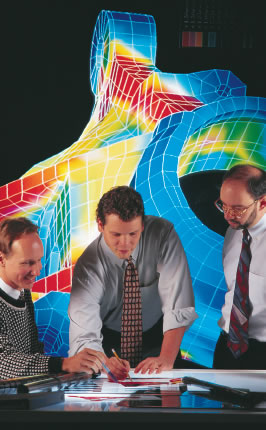 1993 promotional photo for the inaugural release of OptiStruct®. Pictured left to right are George Christ - retired co-founder of Altair; Jeff Brennan - Altair Chief Marketing Officer; and James Scapa - Altair Founder, Chairman and CEO.
1993 promotional photo for the inaugural release of OptiStruct®. Pictured left to right are George Christ - retired co-founder of Altair; Jeff Brennan - Altair Chief Marketing Officer; and James Scapa - Altair Founder, Chairman and CEO.
In the late 1950s, engineers invented a method to study complex geometries undergoing loads. Eventually referred to as the finite-element method, it enabled users to model any geometry in any type of physical condition. Soon after its discovery, the first paper was published suggesting use of this method in an optimization loop to find an optimal, lightweight design.
Thirty years later, research efforts turned to using finite elements and optimization techniques to find the best material distribution in a design space for a given load. At the University of Michigan, for example, professors and students implemented their findings into academic code that simulated bone growth trajectories. When one of the students joined Altair and brought news of this technology with him, Jim Scapa, founder and chief executive officer of Altair, saw the potential in engineering. Altair started collaborating with the University of Michigan and released the first commercial version of the software under the brand name OptiStruct® in 1993.
This theme of optimization – woven throughout the product development process – has been a constant for Altair since the introduction of OptiStruct. Over the years, the company has built upon a solid technological foundation to advance the capabilities of OptiStruct and expand it into a multi-physics solver platform.
Early Accolades
When OptiStruct was introduced, it was enthusiastically received. In 1994, Altair received the coveted Industry Week "Technology of the Year" award for OptiStruct.
Early adopters included engineers in automotive companies like General Motors, Opel, Volkswagen and Audi. They recognized the potential of the technology for saving material in product development. By starting a design with a material layout that follows the load paths – and is, therefore, optimal – they were able to achieve material savings and reduce the number of design iterations downstream.
In 1996, Altair brought 100% of the development of OptiStruct in-house to aggressively advance the technology and deeply integrate it with its growing suite of CAE offerings. Renowned optimization and software specialists Harold Thomas and Yaw-Kang Shyy joined the company. After only nine months, the first version of the new generation OptiStruct was released. One of the first projects included the design of an engine mount bracket from Volkswagen. The 23% weight reduction was impressive.
As an early stage disruptive technology driven by growing industrial application, the development team worked hard on usability and functionality to fuel adoption and its value to the product development community. One area on which they concentrated was the need to consider manufacturing constraints right from the beginning. They introduced techniques such as filtering out small design features and considering draw directions for castings.
A New Century, More Innovations
Though first adopted in the automotive industry, material layout via optimization techniques trickled into other industries. In 2000, aviation giant Airbus engaged with Altair to find the optimal material layout for the leading-edge wing ribs of its new superjumbo A380. Several hundred kilograms of material could be saved on a single plane. Soon after, Boeing also adopted the technology.
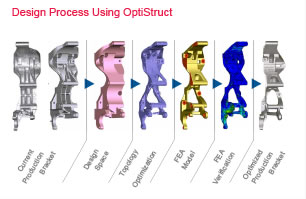 Courtesy of Volkswagen AG
Courtesy of Volkswagen AG
Since "structural optimization" as a discipline was still somewhat unknown and unfamiliar to engineers, Altair introduced a new service model called the Optimization Center. This model placed consulting engineers from Altair ProductDesign together with client engineers to solve the toughest weight reduction challenges posed in their product development process. In fact, Altair's consulting arm was instrumental in driving both the adoption of optimization technology and OptiStruct software development.
With wider adoption of OptiStruct technology, more requirements arose. For example, new physical phenomena needed to be introduced to the models in addition to static load path analysis. Further, more manufacturing techniques had to be considered during the conceptual stage of the design process in order to derive the right shape.
The need for more physics led to the implementation of such phenomena as structural stability, noise and vibration, temperature loading, impact loading, dynamics of mechanical systems, etc. Altair's vision of simulation and optimization-driven design required that any new physics introduced into the solution also needed to be integrated with optimization. There is not simply a need for multi-physics simulation but rather for multi-physics-driven design and optimization.
As such, Altair embarked on a path to develop technology, including MotionSolve®, a multibody simulation code, as well as to acquire technology, such as RADIOSS®, a renowned crash simulation code. RADIOSS and MotionSolve have been integrated seamlessly and are used in unison with native OptiStruct solutions.
Development Trends
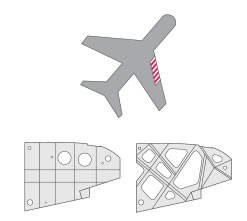
Traditional Design
OptiStruct used to optimize the design of parts like the leading-edge wing rib package shown above can result in as much as 40% mass reduction and a weight saving of over 500 Kg per aircraft.
Advances in manufacturing, including the introduction of new materials and 3D printing, are currently the biggest contextual drivers for the development of OptiStruct. Boeing's 787 Dreamliner project has brought a lot of attention to the effective use of composite materials in product development. The layout for such materials is not trivial. Exploiting the nearly unlimited flexibility of composites in design requires a simulation-driven process.
Composites allow structures that are completely customized to the respective loads. Only computer simulation and optimization can evaluate a large number of variants to arrive at the best possible solution. In this field, Altair engineers have designed an innovative new methodology for composite materials layout, and the approach has been well-suited to projects within the aerospace industry. In fact, the technology has won several awards for lightweighting innovation.
Recently, additive manufacturing, or 3D printing, has moved into the engineering mainstream. The biggest advantage of this approach to manufacturing is the near absence of design constraints. Additive manufacturing is very flexible and can actually produce the designs that are conceived via material layout optimization with little to no rework. Some processes even allow multiple materials in a single part. Other advantages include in situ manufacturing, reduction of lead time and removal of most logistics cost. This technology is tremendously promising and is the perfect manufacturing complement to OptiStruct to achieve the most efficient structural designs.
A Broad Platform
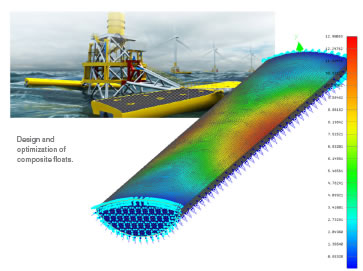
Aside from the capabilities of OptiStruct as a concept development tool, its platform enables a multitude of physics to be solved in parallel, coupled, or sequentially. Through the integration of new solvers, numerical procedures and material models, OptiStruct has matured into a multi-physics solver platform addressing complex loading environments. New optimization methods have been integrated, and the development team has consistently targeted ease of use, helping users choose the appropriate solution approach.
It is important to simulate multi-physics and to make models that represent real physics correctly. However, simulation results only describe a state. Of course, evaluating a number of parameters through multiple simulations helps comprehension of their influences. The question remains: What next?
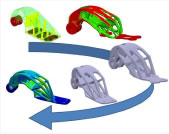 3D printed optimized aircraft door hinge bracket using the optimization engine available in OptiStruct and solidThinking Inspire.
3D printed optimized aircraft door hinge bracket using the optimization engine available in OptiStruct and solidThinking Inspire.
Knowing the sensitivity of a response with respect to a design parameter does enable insights on how to change the parameters. Thinking about it will only yield the right answer occasionally, whereas optimization algorithms automatically trade different attributes towards the given requirement, yielding the right answer with a higher degree of certainty. Altair multi-physics uses optimization to leverage and trade different simulations of different disciplines to achieve design goals.
Strategic Design
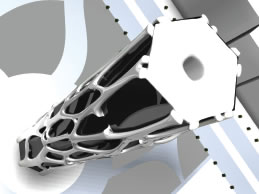 Structural form-finding and multidisciplinary optimization with OptiStruct allow architects to explore and experiment with new shapes and new materials to build complex, innovative building structures.
Structural form-finding and multidisciplinary optimization with OptiStruct allow architects to explore and experiment with new shapes and new materials to build complex, innovative building structures.
A conceptual tool like OptiStruct, used early in the design process, enables strategic design – knowing where the load paths are, where to add or remove material, or where and how to modify a shape based upon materials considerations – which can improve design outcome. Given that OptiStruct is complex finite-element software, designers may not be willing to invest the time to ascend a rather steep learning curve. With that in mind, Altair has developed solidThinking Inspire®, a conceptual design tool that incorporates material layout via optimization into an intuitive interface. This software has introduced a new mode of user interaction, whereby designers interact with and develop virtual prototypes based on optimized geometry. Details of the computational setup are hidden.
Altair's understanding of the relationship between simulation and optimization is a big differentiator for the company. Physics may be complex, and brining relevant simulation into the design requires the use of optimization throughout the process.
Moving forward, Altair will continue to build on its solid foundation of optimization tools. There are other domain areas that are unfamiliar with this message of optimization. Altair looks forward to the opportunity of expanding knowledge and providing the tools that enable users to innovate better products.
For more information on OptiStruct and solidThinking Inspire, visit www.c2rmagazine.com/2015.